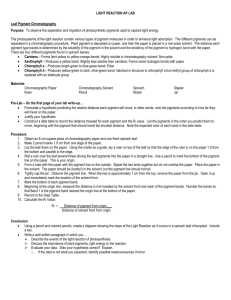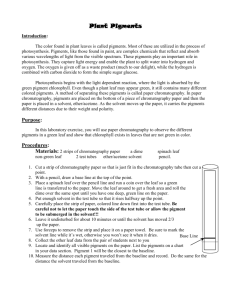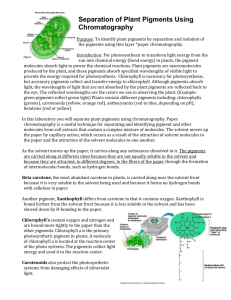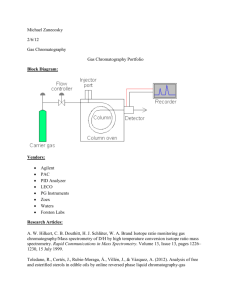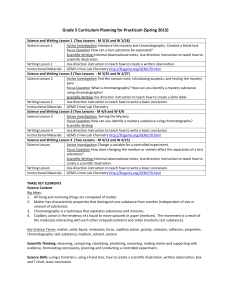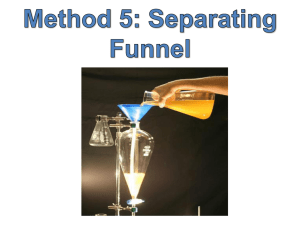Lab 4: A- Leaf Pigment Chromatography
advertisement
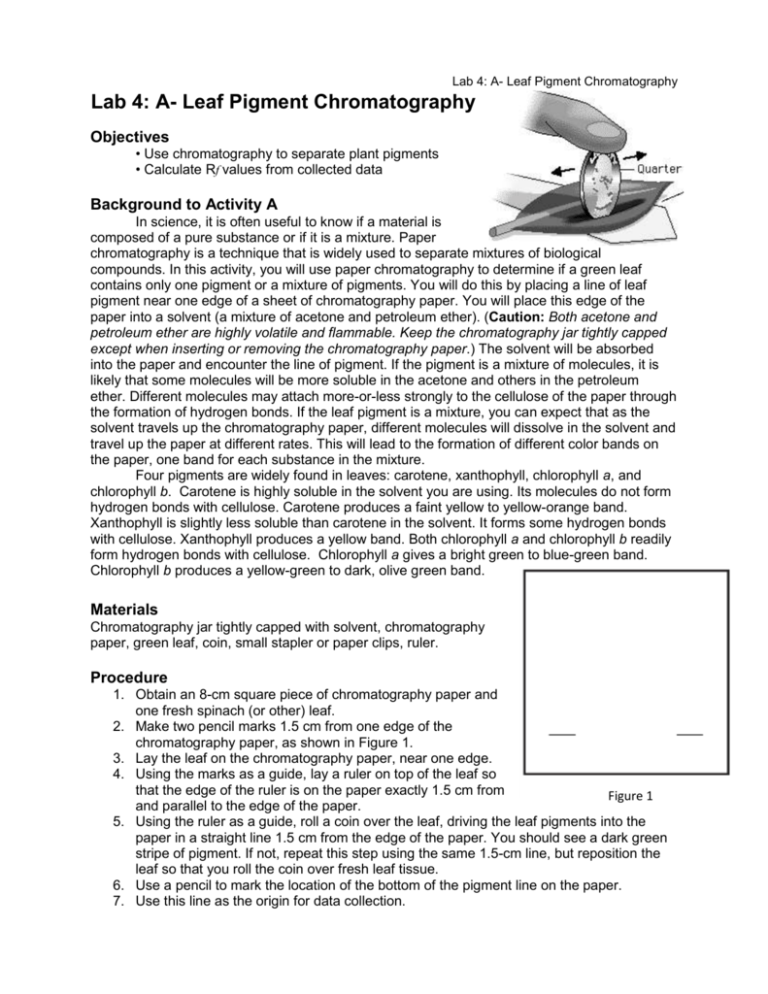
Lab 4: A- Leaf Pigment Chromatography Lab 4: A- Leaf Pigment Chromatography Objectives • Use chromatography to separate plant pigments • Calculate Rf values from collected data Background to Activity A In science, it is often useful to know if a material is composed of a pure substance or if it is a mixture. Paper chromatography is a technique that is widely used to separate mixtures of biological compounds. In this activity, you will use paper chromatography to determine if a green leaf contains only one pigment or a mixture of pigments. You will do this by placing a line of leaf pigment near one edge of a sheet of chromatography paper. You will place this edge of the paper into a solvent (a mixture of acetone and petroleum ether). (Caution: Both acetone and petroleum ether are highly volatile and flammable. Keep the chromatography jar tightly capped except when inserting or removing the chromatography paper.) The solvent will be absorbed into the paper and encounter the line of pigment. If the pigment is a mixture of molecules, it is likely that some molecules will be more soluble in the acetone and others in the petroleum ether. Different molecules may attach more-or-less strongly to the cellulose of the paper through the formation of hydrogen bonds. If the leaf pigment is a mixture, you can expect that as the solvent travels up the chromatography paper, different molecules will dissolve in the solvent and travel up the paper at different rates. This will lead to the formation of different color bands on the paper, one band for each substance in the mixture. Four pigments are widely found in leaves: carotene, xanthophyll, chlorophyll a, and chlorophyll b. Carotene is highly soluble in the solvent you are using. Its molecules do not form hydrogen bonds with cellulose. Carotene produces a faint yellow to yellow-orange band. Xanthophyll is slightly less soluble than carotene in the solvent. It forms some hydrogen bonds with cellulose. Xanthophyll produces a yellow band. Both chlorophyll a and chlorophyll b readily form hydrogen bonds with cellulose. Chlorophyll a gives a bright green to blue-green band. Chlorophyll b produces a yellow-green to dark, olive green band. Materials Chromatography jar tightly capped with solvent, chromatography paper, green leaf, coin, small stapler or paper clips, ruler. Procedure 1. Obtain an 8-cm square piece of chromatography paper and one fresh spinach (or other) leaf. 2. Make two pencil marks 1.5 cm from one edge of the chromatography paper, as shown in Figure 1. 3. Lay the leaf on the chromatography paper, near one edge. 4. Using the marks as a guide, lay a ruler on top of the leaf so that the edge of the ruler is on the paper exactly 1.5 cm from Figure 1 and parallel to the edge of the paper. 5. Using the ruler as a guide, roll a coin over the leaf, driving the leaf pigments into the paper in a straight line 1.5 cm from the edge of the paper. You should see a dark green stripe of pigment. If not, repeat this step using the same 1.5-cm line, but reposition the leaf so that you roll the coin over fresh leaf tissue. 6. Use a pencil to mark the location of the bottom of the pigment line on the paper. 7. Use this line as the origin for data collection. Lab 4: A- Leaf Pigment Chromatography 8. Form a cylinder with the chromatography paper (see Figure 2) by stapling or paper-clipping each end, so that the two edges do not overlap. 9. Place the chromatography paper in the jar so that the pigment streaked end of the paper is barely immersed in the solvent. The pigment stripe itself should not be in the solvent (see Figure 3). Caution: Avoid breathing fumes from the solvent. 10. Tightly cap the jar. Do not disturb the jar for several minutes, but continue to observe the chromatography paper within. 11. When the solvent is about 1 cm from the top margin of the paper, remove the paper from the jar and immediately mark the location of the solvent front before it evaporates. 12. Mark the bottom of each pigment band. 13. Beginning at the origin line, measure the distance traveled by the solvent front and each of the pigment bands. 14. Record the results in Table 1. Number the bands so that Band 1 is the pigment band nearest the origin line at the bottom of the paper. Data: Table 1: Chromatography of Plant Pigments Distance from origin (mm) Solvent front Band # Band Color Pigment Identification Rf Value Analysis of Results For a given solvent and substrate system (in this case, cellulose), each pigment will move a distance that is proportional to the distance moved by the solvent. This is expressed as the Rf (Reference front) value, and it is a constant for the solvent/substrate/pigment. For example, suppose that a pigment moves 75 mm while the solvent moves 100 mm. Then Rf = distance of pigment from origin distance of solvent front from origin Rf = 75 mm 100 mm = 0.75 Calculate Rf values for each of the pigment bands you have identified. Record this data in Table 1. Using the data you have collected, make at least tentative identifications of the chlorophyll band(s) and other major bands on your chromatography paper. Record these in the “Band Color” and “Pigment Identification” columns of Table 1. Lab 4: A- Leaf Pigment Chromatography Conclusion Questions 1. What factors are involved in the separation of pigments? 2. What would the chromatography paper look like if the leaf pigment was not a mixture? 3. Would you expect the Rf value to be the same, if a different solvent were used for the chlorophyll chromatography? Explain. 4. What is the Rf value for carotene calculated from the chromatogram below? (show work)

